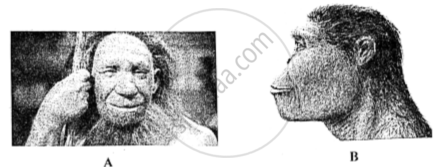Advertisements
Advertisements
Question
Complete the following paragraph with the words given in brackets.
(Cro-Magnon, brain, fire, agriculture, Cultural, homo-sapiens, wise man)
Evolution of upright man continued in the direction of developing its ________ for the period of about 1 lakh years and meanwhile it discovered the __________. Brain of a 50 thousand year old man had been sufficiently evolved to the extent that it could be considered as a member of the class _______. Neanderthal man can be considered as the first example of _______. The _______ man evolved about 50 thousand years ago and afterwards, this evolution had been faster than the earlier. About 10 thousand years ago, wise-man started to practice the _______. It started to rear the cattle-herds and established the cities. _______ development took place.
Solution
Evolution of upright man continued in the direction of developing its brain for the period of about 1 lakh years and meanwhile it discovered the fire. Brain of a 50 thousand year old man had been sufficiently evolved to the extent that it could be considered as a member of the class homo-sapiens. Neanderthal man can be considered as the first example of wise man. The Cro-Magnon man evolved about 50 thousand years ago and afterwards, this evolution had been faster than the earlier. About 10 thousand years ago, wise-man started to practice the agriculture. It started to rear the cattle-herds and established the cities. Cultural development took place.
APPEARS IN
RELATED QUESTIONS
Distinguish between ape and man.
In evolutionary terms, can we say which among bacteria, spiders, fish and chimpanzees have a ‘better’ body design? Why or why not?
Try to trace the various components of human evolution (hint: brain size and function, skeletal structure, dietary preference, etc.)
Given below are two stages in the evolution of man. Study them and answer the questions that follow:
Name the organisum used as an example to explain ‘Industrial Melanism’.
Given below are two stages in the evolution of man. Study them and answer the questions that follow:
Give two examples of Vestigial organs in humans.
Given alongside are two figures (A and B) representing the two stages of evolution of human beings.

Answer the following:
- Mention any two contrasting characters between the two stages.
- Write all the stages of human evolution in their correct sequence.
- State any two characteristic features of stage B.
Whose fossils were discovered at the site of Shivalik hills, India?
Which of the following set correctly represents members of Hominoidea?
The first fossils of Dtyopithecu were found in ______.
Who constructed flint tools?
The cranial capacity of Homo erectus is ______.
Identify the heavily built, short prehistoric man having cranial capacity of about 1400 cc who is known to bury the dead.
Select the mismatched pair.
The process of evolution of a species whereby characteristics that help individual organisms to survive and reproduce are passed on to their offspring and those characteristics which do not help is not passed on is called ______
The extinct human ancestor who ate only fruits and hunted with stone weapons was:
Homo sapiens have evolved in:
Name the following:
Connecting link between ape and man
Name the following :
Name of advanced pre-historic man
Define the following term:
Bipedalism
